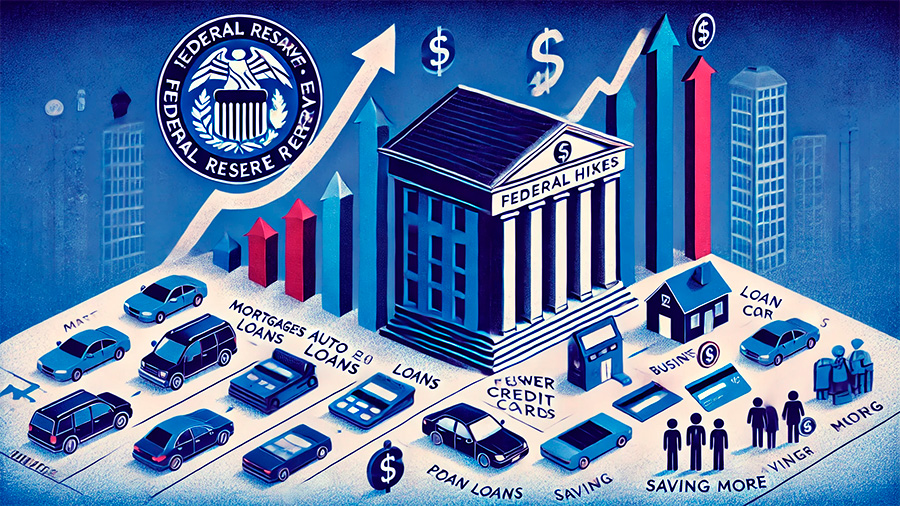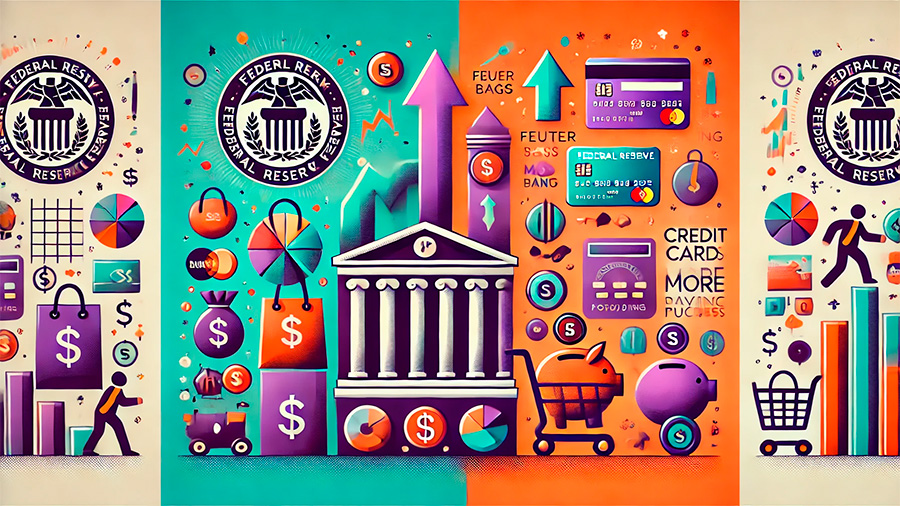When the Federal Reserve (Fed) raises interest rates, it sends a strong signal that the central bank is tightening economic conditions. This action, known as monetary tightening, is aimed at controlling inflation and preventing the economy from overheating. Fed rate hikes affect a broad range of economic activities, from consumer borrowing and spending to business investments and financial markets. Understanding how these rate increases impact various aspects of the economy can help consumers and businesses prepare for the challenges that tighter monetary policy brings.
The Fed’s Role in Managing the Economy
The Federal Reserve uses interest rates as one of its primary tools to manage economic growth and inflation. By adjusting the federal funds rate—the rate at which banks lend to each other overnight—the Fed influences the overall cost of borrowing and lending throughout the economy. When inflation rises or the economy grows too quickly, the Fed raises rates to slow down economic activity. This increase in interest rates makes borrowing more expensive, encourages saving, and ultimately helps to curb inflation by reducing spending.
Fed rate hikes are a clear signal that the central bank is shifting to a more restrictive monetary policy, often in response to concerns about rising inflation or an overheating economy.
How Fed Rate Hikes Signal Economic Tightening
When the Fed raises interest rates, it indicates that the central bank is taking steps to slow economic activity. This process, known as economic tightening, reduces the amount of money circulating in the economy and curtails excessive spending and borrowing. Rate hikes affect everything from the cost of consumer loans to business investment decisions, as higher interest rates make financing more expensive and reduce disposable income.
For businesses, higher borrowing costs can lead to scaled-back expansion plans, reduced hiring, and slower growth. For consumers, rising rates translate into higher mortgage, credit card, and auto loan payments, reducing their ability to spend on goods and services. Together, these factors contribute to a slowdown in economic activity, helping to control inflation but also potentially leading to slower growth or even recession.
Why the Fed Raises Rates
The primary reason the Fed raises interest rates is to manage inflation. When prices for goods and services rise too quickly, the purchasing power of money declines, eroding savings and increasing the cost of living. By raising rates, the Fed makes borrowing more expensive, reducing the demand for loans and slowing consumer spending. This, in turn, helps cool down the economy and bring inflation under control.
In addition to controlling inflation, the Fed may raise rates to prevent asset bubbles. Low interest rates can lead to speculative behavior, as cheap borrowing costs encourage riskier investments. By tightening monetary conditions, the Fed reduces the flow of easy money, making it less attractive to engage in speculative activities like real estate booms or stock market bubbles.

The Impact of Rate Hikes on Borrowing Costs
One of the most immediate effects of Fed rate hikes is the increase in borrowing costs for consumers and businesses. As the federal funds rate rises, so do the interest rates on a variety of loans, including mortgages, auto loans, personal loans, and business loans. Higher interest rates make borrowing more expensive, reducing the amount of credit available and encouraging more cautious financial behavior.
Higher Mortgage and Loan Payments
For consumers, rising Fed rates typically lead to higher mortgage payments, particularly for those with adjustable-rate mortgages (ARMs) or those looking to take out new loans. When interest rates rise, monthly mortgage payments increase, which can make buying a home less affordable or put pressure on household budgets. Auto loans and personal loans also become more expensive, discouraging consumers from taking on new debt or financing large purchases.
This increase in borrowing costs can slow consumer spending, which accounts for a significant portion of overall economic activity. When consumers spend less, businesses experience lower demand, leading to slower sales and potentially reduced profits.
Business Investment and Expansion
For businesses, higher interest rates mean that the cost of financing expansion, capital projects, or inventory purchases increases. Companies may delay or cancel investments if borrowing costs rise too much, which can lead to slower economic growth and reduced job creation. Small businesses, which often rely on credit to finance day-to-day operations, may be hit particularly hard by higher borrowing costs, as they typically face higher interest rates than larger, more established firms.
In addition, businesses may find it more difficult to raise capital through debt markets when interest rates are higher. This can affect everything from hiring plans to research and development, ultimately slowing innovation and economic growth.
Effects on the Financial Markets
Fed rate hikes also have a significant impact on financial markets. As rates rise, the stock market and bond market often react in different ways, with higher interest rates making bonds more attractive relative to stocks. Rising rates can also lead to greater market volatility as investors reassess their portfolios in light of the new economic environment.
Stock Market Volatility
Stock prices tend to fall when interest rates rise, as higher borrowing costs reduce corporate profitability and make future earnings less valuable in today’s terms. Companies that are more reliant on debt financing, such as those in the technology or real estate sectors, may see their stock prices decline more sharply when the Fed raises rates. Additionally, the cost of capital for businesses increases, which can negatively impact their ability to invest in growth and innovation.
Higher interest rates also provide an alternative to stocks in the form of safer, interest-bearing investments such as bonds. As bond yields rise, investors may shift away from stocks toward fixed-income investments, reducing demand for equities and contributing to market volatility.
Bond Market Dynamics
In the bond market, rising interest rates cause the price of existing bonds to fall. This happens because new bonds are issued with higher yields, making older bonds with lower yields less attractive to investors. As a result, bond prices decline, and investors holding long-term bonds may see the value of their holdings decrease. However, for those looking to buy new bonds, rising interest rates offer the opportunity to earn higher yields on their investments.
Short-term bonds tend to be less sensitive to interest rate changes, making them a safer option during periods of rate hikes. Investors may also turn to Treasury bonds, which are backed by the U.S. government and provide a relatively safe return in a rising rate environment.

How Fed Rate Hikes Affect Consumer Behavior
Higher interest rates influence consumer behavior in several ways. When borrowing becomes more expensive, consumers may choose to save more and spend less. As interest rates on savings accounts and other low-risk investments rise, saving becomes more attractive, encouraging consumers to hold onto their money rather than spending it on discretionary items.
Increased Savings and Reduced Spending
With higher interest rates, consumers can earn more on their savings, whether through traditional savings accounts, certificates of deposit (CDs), or other fixed-income investments. This increase in returns incentivizes saving over spending, particularly for individuals who prioritize financial security. As more people save and fewer people spend, economic activity slows, which is the intended effect of monetary tightening.
At the same time, the increased cost of credit card debt and personal loans can discourage consumers from making large purchases or taking on new debt. Higher monthly payments on existing loans reduce disposable income, further constraining consumer spending.
The Broader Economic Implications of Tightening
While Fed rate hikes are primarily aimed at controlling inflation, they have broader implications for the economy as a whole. By tightening economic conditions, the Fed can slow down growth, reduce inflation, and prevent the economy from overheating. However, there is a delicate balance between controlling inflation and pushing the economy into a recession.
Slower Economic Growth
As borrowing costs rise and consumer spending slows, overall economic growth may decelerate. Businesses invest less, consumers spend less, and demand for goods and services decreases. While this slowdown is necessary to bring inflation under control, it can also lead to job losses and lower wages if businesses cut back on hiring or reduce their workforce in response to weaker demand.
In extreme cases, aggressive rate hikes can push the economy into a recession. This risk underscores the challenge faced by the Fed in balancing the need for tighter monetary policy with the goal of maintaining steady economic growth.
Potential for a Recession
While the goal of raising rates is to cool off an overheating economy, doing so too quickly or aggressively can lead to a recession. A recession occurs when economic activity contracts for an extended period, leading to higher unemployment, lower consumer spending, and decreased business investment. If the Fed raises rates too quickly or fails to account for other economic factors, the result can be a sharp slowdown in growth that triggers a recession.
Navigating this delicate balance requires careful monitoring of inflation, unemployment, and other economic indicators to ensure that rate hikes do not go too far and cause more harm than good.
Conclusion: How Fed Rate Hikes Signal Economic Tightening
Fed rate hikes are a clear signal that economic conditions are tightening, as the central bank aims to control inflation and prevent the economy from overheating. Higher interest rates affect everything from borrowing costs and consumer spending to business investment and financial markets. While rate hikes help slow inflation and stabilize the economy, they can also lead to slower growth, reduced spending, and potential volatility in markets. By understanding how Fed rate hikes impact the economy, businesses and consumers can make more informed decisions and prepare for the challenges that tighter monetary conditions bring.

